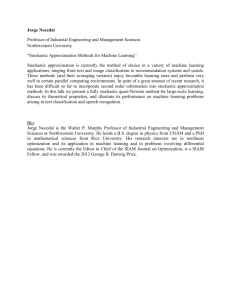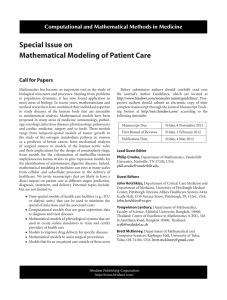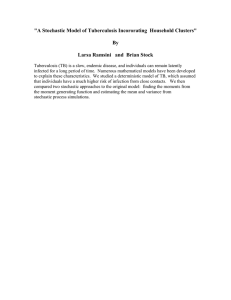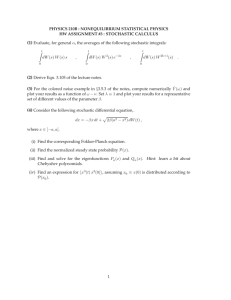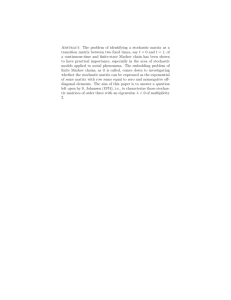Document 10951970
advertisement
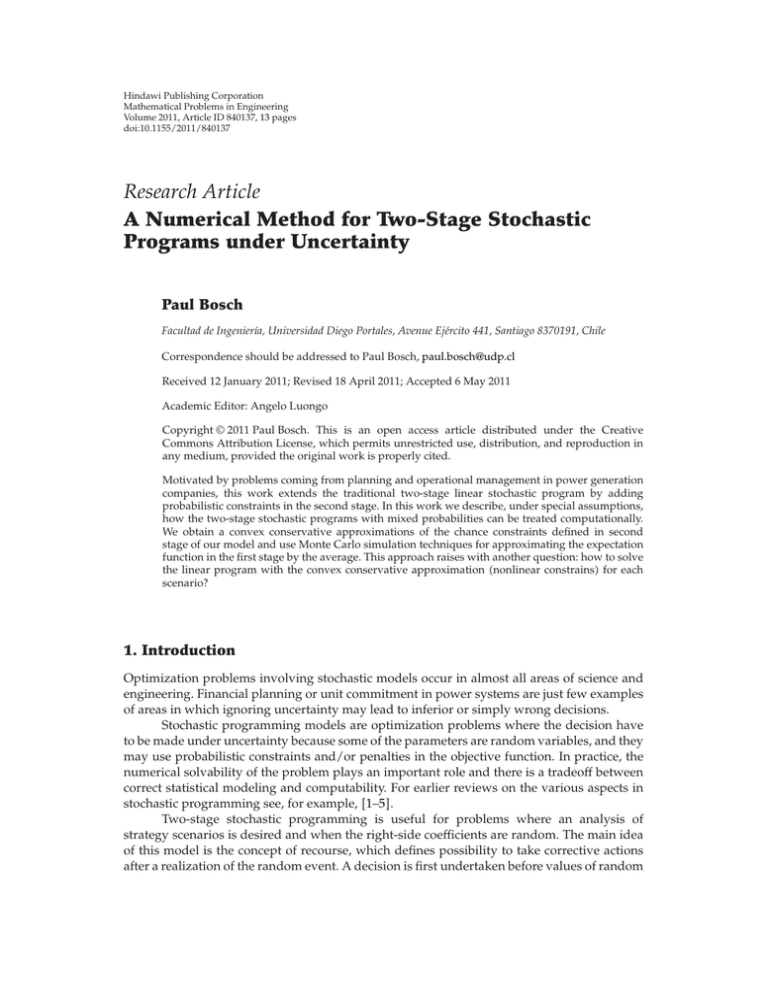
Hindawi Publishing Corporation
Mathematical Problems in Engineering
Volume 2011, Article ID 840137, 13 pages
doi:10.1155/2011/840137
Research Article
A Numerical Method for Two-Stage Stochastic
Programs under Uncertainty
Paul Bosch
Facultad de Ingenierı́a, Universidad Diego Portales, Avenue Ejército 441, Santiago 8370191, Chile
Correspondence should be addressed to Paul Bosch, paul.bosch@udp.cl
Received 12 January 2011; Revised 18 April 2011; Accepted 6 May 2011
Academic Editor: Angelo Luongo
Copyright q 2011 Paul Bosch. This is an open access article distributed under the Creative
Commons Attribution License, which permits unrestricted use, distribution, and reproduction in
any medium, provided the original work is properly cited.
Motivated by problems coming from planning and operational management in power generation
companies, this work extends the traditional two-stage linear stochastic program by adding
probabilistic constraints in the second stage. In this work we describe, under special assumptions,
how the two-stage stochastic programs with mixed probabilities can be treated computationally.
We obtain a convex conservative approximations of the chance constraints defined in second
stage of our model and use Monte Carlo simulation techniques for approximating the expectation
function in the first stage by the average. This approach raises with another question: how to solve
the linear program with the convex conservative approximation nonlinear constrains for each
scenario?
1. Introduction
Optimization problems involving stochastic models occur in almost all areas of science and
engineering. Financial planning or unit commitment in power systems are just few examples
of areas in which ignoring uncertainty may lead to inferior or simply wrong decisions.
Stochastic programming models are optimization problems where the decision have
to be made under uncertainty because some of the parameters are random variables, and they
may use probabilistic constraints and/or penalties in the objective function. In practice, the
numerical solvability of the problem plays an important role and there is a tradeoff between
correct statistical modeling and computability. For earlier reviews on the various aspects in
stochastic programming see, for example, 1–5.
Two-stage stochastic programming is useful for problems where an analysis of
strategy scenarios is desired and when the right-side coefficients are random. The main idea
of this model is the concept of recourse, which defines possibility to take corrective actions
after a realization of the random event. A decision is first undertaken before values of random
2
Mathematical Problems in Engineering
variables are known, and then, after the random events have occurred and their values are
known, a second stage decision is made to minimize “penalties” that may appear because of
any infeasibility. For a good introduction and deepen in various aspects of these models, you
should see the books in 4, 6.
Chance constrained optimization problems were introduced in Miller and Wagner
7, and Prékopa 8. An alternative to the scenario approximation Monte Carlo sampling
techniques is an approximation based on analytical upper bounding of the probability for
the randomly perturbed constraint to be violated. The simplest approximation scheme of
this type was proposed in 9 and for a new class of analytical approximation referred
to as Bernstein approximations, see the works by Nemirovski and Shapiro 10. Another
approximation of probabilities constraints, is by using the Boole-Bonferroni inequalities; see,
for example, 11, 12.
When the stochastic program includes nonlinear terms or when continuous random
variables are explicitly included, a finite-dimensional linear programming deterministic
equivalent does not exist. In this case, we must use some nonlinear programming types of
procedures, see, for instance, 3, 13–16.
In previous work see 17 was extended the traditional two-stage linear stochastic
program by probabilistic constraints imposed in the second stage. In the next section, we
present a summary with assumptions under which the mixed-probability stochastic program
is structurally well behaved and stable under perturbation of both probabilities measures.
Moreover, in 17 can be find, under general conditions, first qualitative continuity properties
for the expectation of the objective function and the constraint set-valued maps. Hence, we
deduced quantitative stability results for the optimal value function and the solution set
under perturbations of probabilities measures.
In the third section, two possible applications that could have this model were shown,
the first one is a summary of the case of planning and operational management in power
generation companies presented in 17 and the other one is an application to the problem of
air pollution.
2. Some Preliminaries: Basic Well-Posedness
In previous work see 17 was introduced the following parametric family of mixed probability stochastic programs P μ, λ:
min c x Qz − Ax, λμdz : x ∈ C ,
μ, λ ∈ Δ × Λ,
2.1
Rs
where Qt, λ is the optimal value function of the problem in second stage:
min q y : Wy t, y ≥ 0, λ Hj y ≥ pj , j 1, . . . , d
and
2.2
i Hj , j 1, . . . , d, are set-valued mappings from Rm to Rr with closed graph;
ii pj , j 1, . . . , d, are predesigned probability levels;
iii if PRs , PRr denote the sets of all Borel probability measures on Rs and Rr ,
respectively, we assume that Δ and Λ are subsets of PRs and PRr ;
iv C is a close subset of Rm .
All remaining vectors and matrices have suitable dimensions.
Mathematical Problems in Engineering
3
This model extends the traditional two-stage linear stochastic program by introducing
some probabilistic constraints λHj y ≥ pj , j 1, . . . , d in the second stage of the problem.
These types of constraints add nonlinearities to the problem and basic arguments to analyze
the well-posedness of P μ, λ were studied in 17.
The major difficulty in understanding the structure of P μ, λ rests in a dilemma about
the function Q.
On the one hand, Q is the optimal-value function of a nonlinear program with
parameters t and λ, and parametric optimization mainly provides local results about the
structure of Q but global results are very scarce and require specific assumptions that are
often hard to verify.
On the other hand, Q arises as an integrand in P μ, λ. For studying properties of the
related integral we require global information about Q.
From this viewpoint, it is not surprising that most of the structural results about twostage stochastic programs concern the purely linear and the linear mixed integer cases, that is,
the widest problem classes where parametric optimization offers broader results about global
stability.
To lay a foundation for the structural analysis of Q we formulate the following general
assumptions.
Assumption A.1. For any λ ∈ Λ there exists a nonempty set Rλ ⊆ Rs and a Lebesgue null set
Nλ ⊆ Rs such that the function Q·, λ is real valued and measurable on Rλ , and continuous
on Rλ \ Nλ .
Assumption A.2. It holds that
μ∈Δ
supp μ ⊆
{Ax Rλ },
2.3
λ∈Λ x∈C
where supp μ denotes the smallest closed set in Rs with μ-measure one.
Assumption A.3. There exists a real-valued, measurable function h on Rs , we call bounding
function, with the following properties.
1 Q-Majorization
It holds that |Qt, λ| ≤ ht for all t ∈ Rλ and all λ ∈ Λ.
2 Integrability
It holds that
Rs
hzμdz < ∞ for all μ ∈ Δ.
3 Generalized Subadditivity
There exists a κ > 0 such that ht1 t2 ≤ κht1 ht2 for all t1 , t2 ∈ Rs .
4 Local Boundedness
For each t ∈ Rs there exists an open neighborhood of t where h is bounded.
4
Mathematical Problems in Engineering
The essence of Assumptions A.1–A.3 is the following: since Q·, λ is the optimalvalue function of a minimization problem it well may attain the values ∞ if the problem
is infeasible and −∞ if the problem is unbounded. Indeed, Assumption A.1 makes sure that
Q·, λ is finite on some set Rλ and A.2 Guarantees that the arguments z − Ax are in Rλ
for all relevant z and x. Otherwise, Qz − Ax, λ would attain infinite values with positive
probability, immediately preventing finiteness of the integral:
Qz − Ax, λμdz.
2.4
G x, μ, λ :
Rs
The continuity part of Assumption A.1 together with Assumption A.3 provides a framework
for applying dominated convergence to show continuity of G·, μ, λ.
Introducing the exceptional set Nλ in Assumption A.1 makes sense, since Q·, λ often
lacks continuity on lower-dimensional subsets of its domain of finiteness.
Furthermore, Assumption A.3 ensures an integrable upper bound for the functions
|Q· − Ax, λ| when x is varying in some neighborhood. Any other set of conditions ensuring
this could be placed instead.
Clearly, h reflects the global growth of |Q·, λ| whose quantitative analysis is acknowledged nontrivial for nonlinear problems.
3. Applications
Motivated by the study of stochastic programming problems coming from planning and
operational management in power generation companies, in previous work see 17 was
presented an example where was consider a power systems of plants to be operated over
a time horizon. In the case of planning and operational management in power generation
companies, the first stage variable x in the model represents generation capacity investment
decisions, such as changes continuous of maximum generation capacity for thermal
plants, the variable z is a random demand and y is the second-stage operational variable
representing the level of production of energy.
The latter is also limited by emission rights for carbondioxide that may concern single
plants or consortia of plants. The level of permitted emission is considered random, since
emission rights are traded at predesigned markets via auctions, for instance, whose outcomes
are uncertain to market participants. This motivates to model limitations on the operational
variables resulting from emission rights by probabilistic rather than deterministic constraints.
Works in 18, 19 have made several applications to model the problem of air pollution;
in these papers authers combine different techniques, including two-stage stochastic
programming. We now present, based on these previous works, a variation of these models
which include restrictions on the type “chance constraints” in the second stage of the model,
that is, an example where there are two completely independent probability measures and of
different nature.
In air quality management systems, there are uncertainties in a variety of pollutionrelated processes, such as pollutant characteristics, emission rates, and mitigation measures.
These uncertainties would affect the efforts in modeling pollutant. On the other hand, because
it is economically infeasible and sometimes technically impossible to design processes
leading to zero emission, decision makers and authorities seek to control the emissions to
levels at which the effects are minimized. The problem is how to minimize the expected
systems cost for pollution abatement while satisfying the policy in terms of allowable
pollutant-emission levels.
Mathematical Problems in Engineering
5
The SO2 generation rates may vary with the type of coal that is used at the power
plants, as well as the related combustion conditions, which could be expressed as a random
variable. As an illustrative example, consider a power system consisting of plants i 1, 2, . . . , I to be operated over a time horizon with subintervals t 1, 2, . . . , T and a set of
control methods j 1, 2, . . . , J. The first stage variables xijt represent the amount of SO2
generated from source i, to be mitigated through control measures j in period t under the
regulated emission allowance, and cjt is the operating cost of control measure j during period
t. The second-stage variables are related to the probabilistic excess SO2 from source i to be
mitigated through control measures j in period t under SO2 generation rate zξ, and djt
is the operating and penalty cost for excess SO2 emission during period t. In general, it is
considered that this cost is much greater than the cost of operating the first stage variables.
The objective is to minimize the total of regular and penalty cost for SO2 abatement.
min
J J T
T
I I cjt xijt djt E yijt .
i1 j1 t1
3.1
i1 j1 t1
If we denote by zit ξ the random variable of SO2 generation rate in source i during period t,
the constraints of pollution control demand are
J
xijt yijt ξ zit ξ,
∀i, t.
3.2
j1
Finally, the function Hyt ξ, ζ represents the accumulation of SO2 in a particular area
sensible, such as a city that is surrounded by emission sources or power plants and which
depends, on the one hand, on the excess amount of emissions from each source i, given
the extent j control taken in period t, and the random variable ζ associated with climatic
conditions and predicts SO2 concentrations in a specific area under different meteorological
conditions, then we add the probabilistic limitations on the second-stage variables:
Pr H yt ξ, ζ ≤ 0 ≥ pt ,
∀t,
3.3
where pt is the probability levels with which the limitations are to be met.
4. Numerical Method
In order to have some idea about how the two-stage stochastic programs with mixed
probabilities can be treated computationally, we will study the following stochastic linear
programming problem:
min cT x EQx, ξ | Bx b, x ≥ 0 ,
4.1
where
Qx, ξ min qT yξ | Ax Wyξ ξ, yξ ≥ 0 ,
s.t. : Pr H yξ, ζ ≤ 0 ≥ 1 − p
4.2
6
Mathematical Problems in Engineering
ξ and ζ represents the independent random variables.
i ξ ∈ Ξ is the possible realizations of the random variable ξ supported on Ξ ⊂ Rs .
ii E stands for expectation with respect to the random variable ξ and yξ ∈ Rm for
each realization ξ.
iii B ∈ Ml×n R, A ∈ Ms×n R, and W ∈ Ms×m R are deterministic matrices and the
probability level p ∈ 0, 1.
iv ζ ∈ Θ is the possible realizations of the random variable ζ supported on Θ ⊂ Rr .
The fundamental idea is to gives a convex conservative approximation of the chance
constrained subproblems 4.2, for this, we will fallow the work by Nemirovski and Shapiro
see 10 and then, have an efficiently solvable deterministic optimization program with the
feasible set contained in the chance constrained subproblem.
Let H : Rm × Θ −→ R, defined by
r
H y, ζ h0 y ζj hj y
4.3
j1
and we assume that the functions hj y, j 1, 2, . . . , r are convex, the components ζj , j 1, 2, . . . , r, of the random vector ζ are independent of other random variables and the moment
generating functions
Mj t : E exp tζj ,
j 1, 2, . . . , r
4.4
are finite valued for all t ∈ R and are efficiently computable.
Then, we have that the problem:
min qT y | Ax Wy ξ, y ≥ 0 ,
⎤
r
−1
s.t. : inf⎣h0 y tΛj t hj y − t log p⎦ ≤ 0
⎡
t>0
4.5
j1
is a conservative convex approximation of the chance constrained subproblems 4.2, for each
realizations of the random variable ξ ξ ∈ Ξ ⊂ Rs , where
Λj t log Mj t.
4.6
Note that this approximation it is known as the Bernstein Approximation is an explicit
convex program with efficiently computable constraints and as such is efficiently solvable.
Now, we can use the Monte Carlo simulation, that is, suppose that we can generate a
sample ξ1 , ξ2 , . . . , ξN of N replications of the random vector ξ and then, we can approximate
the expectation function by the average
EQx, ξ N
1
Q x, ξk
N k1
4.7
Mathematical Problems in Engineering
7
and consequently, we have the sample average approximation method:
N
1
k
min c x Q x, ξ | Bx b, x ≥ 0 ,
N k1
T
4.8
where
Q x, ξk min qT y | Ax Wy ξk , y ≥ 0 ,
⎤
r
s.t. : inf⎣h0 y tΛj t−1 hj y − t log p⎦ ≤ 0.
⎡
t>0
4.9
j1
If we denote by
⎤
⎡
r
−1
ω y inf⎣h0 y tΛj t hj y − t log p⎦
t>0
4.10
j1
we have that ωyk ≤ 0 is a convex constraints and conservative for each k 1, 2, . . . , N, in
the sense that if for
yk ∈ y ∈ Rm | Ax Wy ξk , y ≥ 0
4.11
it holds that ωyk ≤ 0, then
Pr H yk , ζ ≤ 0 ≥ 1 − p
4.12
or equivalently
⎧
⎫
r
⎨ ⎬
Pr h0 yk ζj hj yk ≤ 0 ≥ 1 − p
⎩
⎭
j1
4.13
and we obtain the following deterministic problem, with nonlinear constraints:
min
x,y1 ,...,yN
s.t.
c x N
1
q yk ,
N k1
Bx b,
Ax Wyk ξk , ∀k 1, 2, . . . , N,
ω yk ≤ 0, ∀k 1, 2, . . . , N,
x ≥ 0,
yk ≥ 0,
∀k 1, 2, . . . , N.
4.14
8
Mathematical Problems in Engineering
Remark 4.1. It was demonstrated in theoretical studies and numerical experiments that QuasiMonte Carlo techniques could significantly improve the accuracy of the sample average
approximation problem, for a general discussion of Quasi-Monte Carlo methods see the
works by Niederreiter in 20, 21. Moreover, the problem 4.5 is not the only way to get to
the conservative convex approximation of the chance constrained problems, we also can use
the convex approximation obtained by Conditional Value at Risk see 10 and the work by
Rockafellar and Uryasev 22. However, our aim in this paper is more focused on showing
a numerical methodology to tackle this type of models.
Denote by X {x ∈ Rn | Bx b, x ≥ 0} and Y {y ∈ Rm | wy ≤ 0, y ≥ 0}
the convex subsets of the feasible set of problem 4.14 that do not depend on the sample
generated by the random vector ξ, then the problem 4.14 can be rewritten as
min
s.t.
c x N
1
q yk ,
N k1
Wyk ξk − Ax,
k 1, 2, . . . , N,
4.15
x ∈ X,
yk ∈ Y,
k 1, 2, . . . , N
and then, we can take advantage of separability. If we denote
vuk min q y | Wy uk , y ∈ Y ,
PK where uk ξk − Ax, for all k 1, 2, . . . N, we have
v ξk − Ax max rλ − λ ξk − Ax | λ ∈ Rs ,
4.16
for all k 1, 2, . . . , N and
rλ inf q y λ Wy | y ∈ Y .
4.17
Note that rλ − λ ξk − Ax is the dual function corresponding to v, and the master problem
minc x N 1
v ξk − Ax ,
N k1
M.P.
x∈X
can be solved using a differentiable descent method if rλ inf{q W λ y | y ∈ Y } is
strictly concave function over the set {λ | rλ > −∞}. However, this last assumption is very
Mathematical Problems in Engineering
9
restrictive, in fact, in our specific case is not satisfied because the objective function is linear,
so we would have to study under what conditions the gradient of the value function vu,
can be explicitly calculated.
Since the master problem M.P. has linear constraints, this can be solved using FrankWolfe method, for which only we need to know the gradient of vξk − Ax, but
∇x v ξk − Ax −A ∇uk vuk A λ∗k
4.18
for each k 1, . . . , N, where λ∗k is the Lagrange multiplier associated to linear constraint in the
optimal solution of subproblem PK . Therefore, our problem now is how we find specifically
the value of this multiplier λ∗k .
5. Normal Distribution
In this section we investigate the case when the random vector ζ ζ1 , ζ2 , . . . , ζr supported
on Θ ⊂ Rr , has all its components normally distributed.
Let us suppose that ζj ∼ Nμj , σj2 , j 1, 2, . . . , r, then the moment generating function
is defined as
σj2 t2
5.1
,
Mj t exp μj t 2
Λj t log Mj t μj t σj2 t2
2
5.2
for each j 1, 2, . . . , r.
Proposition 5.1. The Bernstein Approximation of the chance constrained subproblems is given by
!
"
r
r
"
ω y h0 y μj hj y #−2 log p σj2 h2j y .
j1
5.3
j1
Proof. As we saw before, the Bernstein Approximation is a conservative convex approximation of the chance constraints defined as
⎤
⎡
r
−1
ω y inf⎣h0 y tΛj t hj y − t log p⎦
t>0
5.4
j1
and substituting the expression given in 5.2 in the above relationship, we obtain
⎫
⎧
%
$
r
⎬
⎨ h2j y
hj y
− t log p
σj2
ω y inf h0 y t μj
2
⎭
t>0 ⎩
t
2t
j1
⎧
⎫
r
r
⎨ ⎬
1
inf h0 y μj hj y σj2 h2j y − t log p
⎭
t>0 ⎩
2t j1
j1
5.5
10
Mathematical Problems in Engineering
and then
⎧
⎫
r
r
⎨1
⎬
σj2 h2j y − t log p .
ω y h0 y μj hj y inf
⎭
t>0 ⎩ 2t
j1
j1
5.6
Let us denote
' by ft a/2t − t log p the auxiliary function, it is easy to see that the stationary
&
point t −a/2 log p is a global minimum of the function f, therefore, of the given equation
5.6, we can conclude, after some calculations, that
r
'
ω y h0 y μj hj y −2a log p
5.7
j1
and finally, substituting a (r
j1
σj2 h2j y, we have
!
"
r
r
"
ω y h0 y μj hj y #−2 log p σj2 h2j y .
5.8
yk ∈ arg min q y | Wy uk , y ≥ 0
5.9
j1
j1
Proposition 5.2. Let
and suppose that ωy k > 0. Then, there is
yk∗ ∈ arg min q y | Wy uk , y ≥ 0, ω y ≤ 0
5.10
such that ωyk∗ 0.
Proof. The existence of yk∗ depends only on whether the feasibility set
S y ∈ Rm | Wy uk , y ≥ 0 ∩ y ∈ Rm | ω y ≤ 0
5.11
is not an empty set. By the other hand, ωy is a convex function, and then S is a convex set,
so
yk α αyk∗ 1 − αyk ∈ S,
∀α ∈ 0, 1
5.12
and by continuity of ω, if ωyk > 0, there is α ∈ 0, 1 such that ωyk α 0.
Denote by θα q yk α, then θ α q yk∗ − yk ≥ 0 for all α ∈ 0, 1 because
∗
q yk ≥ q yk . This implies that the function θα is monotone increasing in 0, 1, and therefore
θ0 ≤ θα ≤ θ1
5.13
Mathematical Problems in Engineering
11
and then we have q yk α ≤ q yk∗ and
yk α ∈ arg min q y | Wy uk , y ≥ 0, ω y ≤ 0 ,
5.14
where ωyk α 0. Finally, it is enough to assign to yk∗ yk α.
Now, we analyze the two possible cases for each k 1, . . . , N. Let
yk ∈ arg min q y | Wy uk , y ≥ 0 .
5.15
Case 1. If ωyk ≤ 0, then by yk∗ yk and λ∗k is the Lagrange multiplier associated to linear
constraint Wy uk .
Case 2. If ωyk > 0. Using the results of the previous proposition, we have to find the solution
to the penalized problem:
min
q y Ck ω2 y ,
5.16
s.t. Wy uk ,
y≥0
for a penalty parameter Ck sufficiently large. To resolve this problem, we can apply again the
iterative method of Frank and Wolfe, where in each iteration, we solves a linear problem and
then, we have
j1
yk
j
j
j
yk γj y k − yk ,
5.17
where γj is chosen by the limited minimization rule or the Armijo rule,
j
y k ∈ arg min
j j j
y − yk | Wy uk , y ≥ 0
q 2Ck ω yk ∇ω yk
5.18
j
and, if we denote by λk the Lagrange multiplier associated to linear constraint Wy uk
j
in 5.18, and let yk∗ be the accumulation point of the sequence {y k }, that is, there is a
j
subsequence {yk }j∈J that converges to yk∗ , then we define by λ∗k the corresponding limit
j
point of subsequence {λk }j∈J .
6. Conclusions
In this paper, we present a strategy or methodology to be followed to solve a two-stage
stochastic linear programs numerically, when the chance constraints are included in the
second stage. It suggests treating the two measures of probabilities involved in the problem
differently. Since the major difficulty of the problem is in the second stage, we chose to assume
12
Mathematical Problems in Engineering
that we had a sample of replications of random vector involved in the expected value function
in the objective function and approximate it by the average. For the case of chance constraints
defined in second stage, the main idea was to obtain a convex conservative approximation
and then get to an efficiently solvable deterministic nonlinear optimization program for
each scenario considered in the previous sample. Since the number of replicas or sample
size is generally very large, and for each one must solve a nonlinear optimization problem
because a method of decomposition of general deterministic problem were proposed, then
although the problem looks very computationally unwieldy for the special case when the
random vector of probability constraint of the second stage has all its components normally
distributed, an explicitly Bernstein approximation function was obtained and we showed
how each nonlinear optimization problem can be solved separately.
Acknowledgments
The author wish to thank the referees for their careful reading and constructive remark. This
work has been supported by CONICYT Chile under FONDECYT Grant 1090063.
References
1 J. R. Birge and F. Louveaux, Introduction to Stochastic Programming, Springer Series in Operations
Research, Springer, New York, NY, USA, 1997.
2 J. Dupačová, “Stability and sensitivity analysis for stochastic programming,” Annals of Operations
Research, vol. 27, no. 1–4, pp. 115–142, 1990.
3 R. Wets, “Stochastic programming: solution techniques and approximation,” in Mathematical
Programming: The State of the Art (Bonn, 1982), A. Bachem, M. Grötschel, and B. Korte, Eds., pp. 566–
603, Springer, Berli, Germany, 1983.
4 R. J.-B. Wets, “Stochastic programming,” in Optimization, G. L. Nemhauser, A. H. G. Rinnooy Kan,
and M. J. Todd, Eds., vol. 1 of Handbooks in Operations Research and Management Science, pp. 573–629,
North-Holland, Amsterdam, The Netherlands, 1989.
5 R. J.-B. Wets, “Challenges in stochastic programming,” Mathematical Programming, vol. 75, no. 2, pp.
115–135, 1996.
6 A. Ruszczyński and A. Shapiro, Eds., Handbooks in Operations Research and Management Science, Volume
10: Stochastic Programming, Elsevier, Amsterdam, The Netherlands, 2003.
7 L. B. Miller and H. Wagner, “Chance-constrained programming with joint constraints,” Operations
Research, vol. 13, pp. 930–945, 1965.
8 A. Prékopa, “On probabilistic constrained programming,” in Proceedings of the Princeton Symposium on
Mathematical Programming (Princeton Univ., 1967), pp. 113–138, Princeton University Press, Princeton,
NJ, USA.
9 A. Ben-Tal and A. Nemirovski, “Robust solutions of linear programming problems contaminated with
uncertain data,” Mathematical Programming, vol. 88, no. 3, pp. 411–424, 2000.
10 A. Nemirovski and A. Shapiro, “Convex approximations of chance constrained programs,” SIAM
Journal on Optimization, vol. 17, no. 4, pp. 969–996, 2006.
11 A. I. Kibzun and Y. S. Kan, Stochastic Programming Problems with Probability and Quantile Functions,
Wiley-Interscience Serie in Systems and Optimization, Wiley, 1996.
12 A. Prékopa, “Boole-Bonferroni inequalities and linear programming,” Operations Research, vol. 36, no.
1, pp. 145–162, 1988.
13 J. R. Birge and L. Q. Qi, “Subdifferential convergence in stochastic programs,” SIAM Journal on
Optimization, vol. 5, no. 2, pp. 436–453, 1995.
14 J. Birge and M. Teboulle, “Upper bounds on the expected value of a convex function using gradient
and conjugate function information,” Mathematics of Operations Research, vol. 14, no. 4, pp. 745–759,
1989.
15 Y. Ermoliev and R. J.-B. Wets, Eds., Numerical Techniques for Stochastic Optimization, vol. 10 of Springer
Series in Computational Mathematics, Springer, Berlin, Germany, 1988.
Mathematical Problems in Engineering
13
16 S. Uriasiev, “Adaptive stochastic quasigradient methods,” in Numerical Techniques for Stochastic
Optimization, pp. 373–384, Springer, Berlin, Germany, 1988.
17 P. Bosch, A. Jofré, and R. Schultz, “Two-stage stochastic programs with mixed probabilities,” SIAM
Journal on Optimization, vol. 18, no. 3, pp. 778–788, 2007.
18 Y. Li, G. H. Huang, A. Veawab, X. Nie, and L. Liu, “Two-stage fuzzy-stochastic robust programming: a
hybrid model for regional air quality management,” Journal of the Air & Waste Management Association,
vol. 56, no. 8, pp. 1070–1082, 2006.
19 K. Saenchai, L. Benedicenti, and G. H. Huang, “A mixed-integer two-stage interval stochastic
programming model for regional air quality management,” Environmental Informatics Archives, vol.
5, pp. 168–176, 2007.
20 H. Niederreiter, Random Number Generation and Quasi-Monte Carlo Methods, vol. 63 of CBMS-NSF
Regional Conference Series in Applied Mathematics, SIAM, Philadelphia, Pa, USA, 1992.
21 H. Niederreiter, “Quasi-Monte Carlo methods for multidimensional numerical integration,” in
Numerical Integration, III (Oberwolfach, 1987), H. Bra and G. Hammerlin, Eds., vol. 85 of International
Series of Numerical Mathematics, pp. 157–171, Birkhäuser, Basel, Switzerland, 1988.
22 R. T. Rockafellar and S. P. Uryasev, “Optimization of conditional value at risk,” Journal of Risk, vol. 2,
pp. 21–41, 2000.
Advances in
Operations Research
Hindawi Publishing Corporation
http://www.hindawi.com
Volume 2014
Advances in
Decision Sciences
Hindawi Publishing Corporation
http://www.hindawi.com
Volume 2014
Mathematical Problems
in Engineering
Hindawi Publishing Corporation
http://www.hindawi.com
Volume 2014
Journal of
Algebra
Hindawi Publishing Corporation
http://www.hindawi.com
Probability and Statistics
Volume 2014
The Scientific
World Journal
Hindawi Publishing Corporation
http://www.hindawi.com
Hindawi Publishing Corporation
http://www.hindawi.com
Volume 2014
International Journal of
Differential Equations
Hindawi Publishing Corporation
http://www.hindawi.com
Volume 2014
Volume 2014
Submit your manuscripts at
http://www.hindawi.com
International Journal of
Advances in
Combinatorics
Hindawi Publishing Corporation
http://www.hindawi.com
Mathematical Physics
Hindawi Publishing Corporation
http://www.hindawi.com
Volume 2014
Journal of
Complex Analysis
Hindawi Publishing Corporation
http://www.hindawi.com
Volume 2014
International
Journal of
Mathematics and
Mathematical
Sciences
Journal of
Hindawi Publishing Corporation
http://www.hindawi.com
Stochastic Analysis
Abstract and
Applied Analysis
Hindawi Publishing Corporation
http://www.hindawi.com
Hindawi Publishing Corporation
http://www.hindawi.com
International Journal of
Mathematics
Volume 2014
Volume 2014
Discrete Dynamics in
Nature and Society
Volume 2014
Volume 2014
Journal of
Journal of
Discrete Mathematics
Journal of
Volume 2014
Hindawi Publishing Corporation
http://www.hindawi.com
Applied Mathematics
Journal of
Function Spaces
Hindawi Publishing Corporation
http://www.hindawi.com
Volume 2014
Hindawi Publishing Corporation
http://www.hindawi.com
Volume 2014
Hindawi Publishing Corporation
http://www.hindawi.com
Volume 2014
Optimization
Hindawi Publishing Corporation
http://www.hindawi.com
Volume 2014
Hindawi Publishing Corporation
http://www.hindawi.com
Volume 2014
